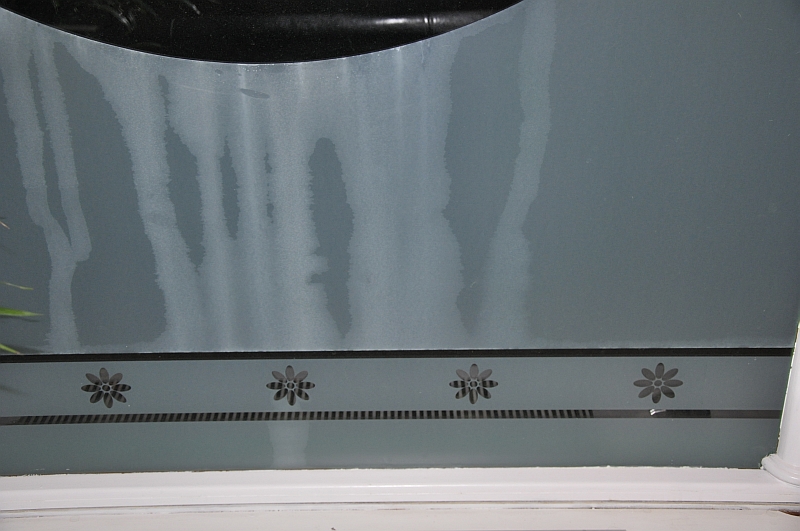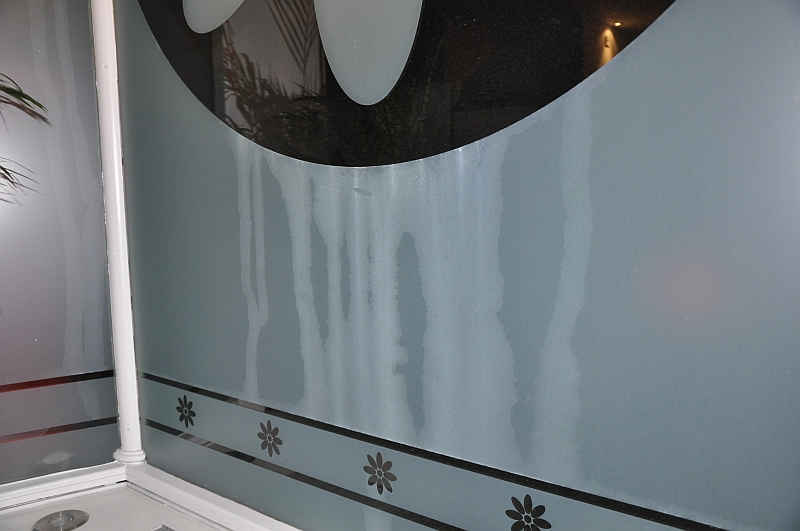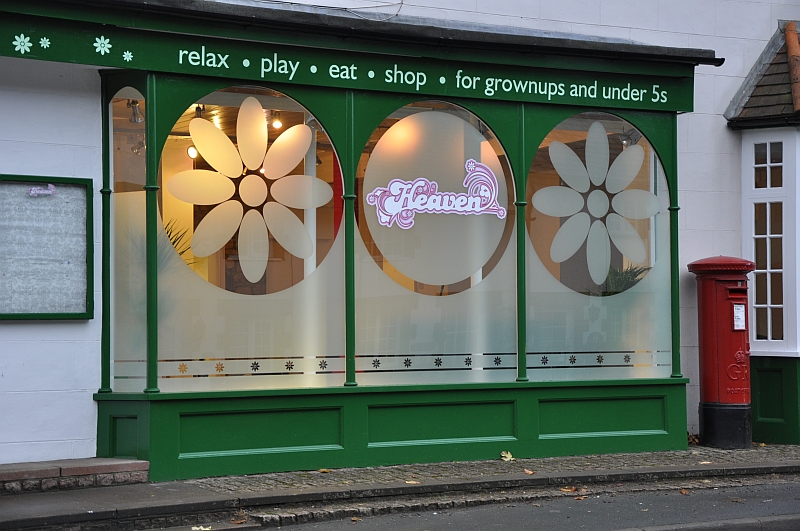Activity Feed › Forums › Sign Making Discussions › Vinyl › Can anyone explain this discoloration?
-
Can anyone explain this discoloration?
Posted by Peter Dee on November 12, 2010 at 10:10 amWe applied some Hexis E9005 cast etch (solvent adhesive) to some windows.
Last Monday (6 days after application) the business opened (a childcare nursery). It was a horrible rainy day and the heating in the room failed causing the windows to condensate heavily.
Following this we were called in because the vinyl had become discoloured.
It appears that the heavy wetness pooled and got behind the vinyl in places, although there is also some marking at just the bottom edges.
The marking shown can not be squeegeed out as the vinyl is absolutely flat with no fluid remaining. The large areas were applied wet with Rapid-Tac. The lower stripes applied dry (which in places have also been affected).
On peeling back the vinyl the discoloration is IN the vinyl and can not be rubbed off. The glue is still in place being solvent adhesive.
I would love an explanation prior to doing it all again.Peter Dee replied 13 years, 5 months ago 12 Members · 19 Replies -
19 Replies
-
WOW! Never seen this before to such an extent!
Rapid Tac may be the issue here or defective roll of the vinyl.
Can’t see any other explanation to be honest!
Weve done thousands of windows with all types of media, and I can honestly say I’ve never seen this before!
Matt
-
I don’t know where you are in the country, just thinking aloud as you mention re the heating. Wondered if the condensation had got behind it and frozen?
-
No it hadn’t frozen.
Update; I’ve re-cut all the graphics ready for fitting dry.
Turned up some 5 days after this photo and the effect has virtually disappeared.
I was gobsmacked!
I guess the prolonged damp between the glass & vinyl caused it to temporarily dis-colour.
I’m leaving it a bit longer now to see if it clears completely.
Lesson learnt.Picture shows the finished job.
-
Cant help with the problem cause…..
But REALLY liking those windows! Nice job. 😀
-
We’ve had ‘milking’ before when fitting wet in this horrid damp/cold weather. It does go away eventually, but I always fit dry now to avoid this happening.
Perversely, I find fitting etch dry in the cold & damp weather far easier than fitting wet at all.
-
Peter, pity you recut the graphics so quickly, least if it disappears it will save you the time and effort of removing and re applying.
Like the others have said windows look great.
-
This isn’t a lot of help now, but when you went back a squeegeed the water out, although the colour remained different, you’d already fixed it. I’ve had a very similar thing on a launderette I done. (The condensation was ridiculous, if I’d realise it’d be that bad I’ve have written them on the outside). I went back, squeegeed it, dabbed it with a paper towel and said we’ll give it a fews days to see what it drys like, if it’s doesn’t do what I think it will I’ll replace it. Once fully dried, it was perfect.
Some frosts and indeed vinyls can change colour massively when they dry out, you must have noticed how white looks so dirty when applied to glass until the adhesive cures.
I’ve also tinted car windows on cold days with the car heater on, it doesn’t condensate, but you get a whole range of streaks and clouds on the windows till it dries out. It goes from looking unsellable to perfect in a couple of hours. It also has no effect on the longevity of the job.
-
moral is, if you can, then apply dry, job done and client happy.
I think fitting wet and leaving the job with milk staines is unacceptable,
when you walk off the site the product should be finished, Just my opinionPete
-
quote Peter Normington:when you walk off the site the product should be finished, Just my opinion
Pete
Nah!
Some things take time to "bed in" before they are finished.
Heineken Lager takes 4 weeks to mature properly. Imagine the head brewer at Heineken being told the beer must be perfect as soon as he had finished making it 🙄
-
Yes but surely he hasn’t finished making it until it is fully matured so in effect it is finished as soon as he has finished making it 😉
-
quote Phill Fenton:quote Peter Normington:when you walk off the site the product should be finished, Just my opinion
Pete
Nah!
Some things take time to “bed in” before they are finished.
Heineken Lager takes 4 weeks to mature properly. Imagine the head brewer at Heineken being told the beer must be perfect as soon as he had finished making it 🙄
they dont send it to the customer before its matured though,do they?
😀Peter
-
While I wouldn’t argue generally about applying window stuff dry I have to say some jobs I wouldn’t fancy doing on my own dry. Wet is the solution just so I can handle larger graphics. Not ideal for sure but there you go.
Alan D -
quote Peter Normington:moral is, if you can, then apply dry, job done and client happy.
I think fitting wet and leaving the job with milk staines is unacceptable,
when you walk off the site the product should be finished, Just my opinionPete
Peter, the job was perfect when we left with no stains whatsoever.
They didn’t happen until 6 days later when the heating failed and caused massive condensation, and obviously due to the cold the adhesive wasn’t fully cured on the cold glass.
We did the large bottom curves wet due to the awkward shape and size 1440mm x 1200mm. -
Peter.
Yes I did read the post, and I not knocking your installation skills,
I am sure it was perfect when you left, and unfortunate that for whatever reason the milkiness appeared later.
I was commenting in general, after Bob’s post
I also agree that wet is sometimes better and easier for fitting large pieces, especially for single handed application.Love the design though
Peter
-
The window tint obviously can’t be applied dry, so unless you have a nice big heated workshop, if it’s winter you’ve got to do it outside with the car heater on. It only looks streaky for a couple of hours, so I make sure it’s not collected till it’s dry.
If you’d actually read what I’d said Peter, vinyl changes colour while it cures, it doesn’t matter if it’s applied wet or dry. Because it’ll be even, it won’t notice as it’ll all cure at the same time. Emulsion/gloss/cellulose/2k etc all changes colour as it cures.
Peter Dee, you probably just missed one little bit in the centre, it was probably like it all the time but only became noticeable once flooded with water. I must admitt I’d have expected it to start noticing sooner, it probably did if the truth we’re known, but no one paid any attention to it.
I would have stuck it wet, without question, would this have happened if I’d done the job, quite possibly we’re only human.
If dry application is so easy without bubbles, which I’m sure it isn’t when you see so of the jobs out there. Why are all manufacturers making and developing vinyls that don’t leave bubbles if it’s not a real problem.
-
We never stop learning do we.
Thanks for the input.
BTW, the etch is very pale green cast and looks even better in the flesh.
When first shown the job with those round topped windows I thought a good design was going to be tough. In fact it was until I hit on the idea of the circle effect. Wouldn’t mind a few more jobs like this. -
I fit quite a bit of both Vinyl Frost and Window Film Polyester Frost.
The polyester can only be applied wet, It is more opaque than a lot of vinyls and has a longer estimated lifespan.
With the polyester I have had occasionally small fingers pop up in areas of high condensation. Even as much once that a hair dryer had to be used to warm the film and dry out the condensation. Of course I wouldn’t generally recommend using heat on a plate glass window but a hair dryer rather than a heat gun and by constantly feeling the glass to make sure it never gets hot can help. The manufacturer of the film actually said that the film glue was so agressive that even after a few weeks as long as there is no contamination the fingers can be pushed down with a very light heat. The water / condensation has no effect on the film or glue as it is made to be applied wet.As for Vinyl frost, I find although I have installed it both wet and dry I prefer dry for intricate graphics so the application paper can be removed but wet for large unbroken areas. I don’t find it particularly an installation problem doing it dry, although wet is more forgiving, but find the finished window is immediately more even looking.
Doing vinyl frost dry (I usually use Metamark frost, clear or dusted etch) I find that without application paper the squeegee can leave white marks on the frost either where you start a squeegee swipe or finish it, because of slight differences in pressure. Also any small specks of contamination are highlighted by a tiny spot.
Whether you do the window wet or dry it has obviously to be scrupulously clean. This involves cleaning fluid or water of some sort and if there is condensation in the room it is virtually impossible to get it completely dry again afterwards so applying wet removes this problem. Tiny specs of contamination if any are left after the cleaning are often pushed to the edge by the liquid or sealed in without white marks as no air is there.
So usually I do even vinyl wet and treat it like window film with a 3 part regime of scraping cleaning and rinsing the glass and all edges before application. I use a window film clear-max squeegee directly on the vinyl without application paper and after being trimmed go over the whole area again very aggressively with a hard card covered in paper towel or microfibre cloth concentrating on the edges to make sure all water is expelled and removed from sitting on the edge of the film by the frame. This bumping of the edges is a crucial part of film installation to stop water getting back under the film.
When I first saw this post my immediate thoughts were it would dry out but have no experience of the Hexis vinyl so was not sure if it discoloured like this when wet.
I am glad to hear that it did so and would always say to a customer that it may take at least 30 days to cure and any uneven marks to disappear. In fact in winter and humid conditions my written advice to all customers say this drying time may even increase to 3 months.
This is the drying out period stated by most film manufacturers and I use this information for vinyl as well.
I would always show this to customers on leaving and not consider redoing a window till at least 3 months after application.So for me wet, but have patience.
Log in to reply.





